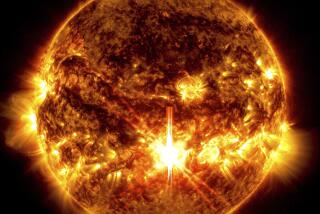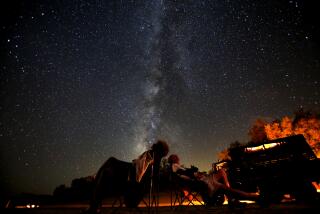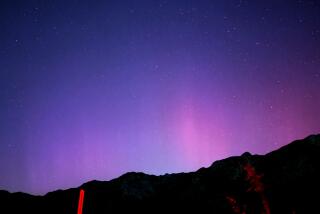Massive solar flare ripples sun’s surface; storms speed to Earth
A powerful solar flare Tuesday evening caused the surface of the sun to shudder. A second smaller flare followed about an hour later, and the blasts caused by those flares have hurled a “big blob of magnetized material” toward Earth.
So says Alex Young, solar physicist at NASA Goddard, who spoke with The Times on Wednesday about the flares and their predicted impact.
The results of the coming geomagnetic storm may be pleasant -- auroras as far south as Illinois -- or unpleasant, such as GPS and communications problems, according to Young.
The first flare was the second largest of the current 11-year solar cycle, which began in 2008, with activity expected to peak next year, he said. The second was less impressive but also did its part in kicking up a storm.
“The main concern for space weather is the blast,” or “coronal mass ejection,” that follows a flare, Young said. That blast releases a huge amount of material into space -- solar plasma as well as ionized gas that contains a magnetic field.
On a scale of 1 to 5, Young said, the geomagnetic storm has been pegged at 2 or 3, moderate to slightly strong.
When the material from the coronal mass ejection hits the Earth’s magnetic field -- or magnetosphere -- it causes the field to “ring like a bell,” or oscillate, Young said. This generates electrical currents that move around in the upper atmosphere and, when strong enough, causes electrical currents on the ground.
That means possible disruptions in electricity distribution -- “severe storms can knock out power grids,” Young said. GPS and radio communications can be affected, and electrical currents can even be picked up by oil pipelines, contributing to their corrosion.
The coronal mass ejection is expected to hit the Earth at about 1:30 a.m. Eastern time Thursday -- with a margin of error of plus or minus seven hours.
But if they’re lucky, in the wee hours of Thursday morning, residents of northern New York and Idaho -- or even Illinois if the conditions are right -- could be treated to auroras, those colorful light displays in the nighttime sky that are usually confined to the high and low latitudes.
ALSO:
More Americans believe in global warming
Hawaii flooding: Disaster declared on two islands
More to Read
Sign up for Essential California
The most important California stories and recommendations in your inbox every morning.
You may occasionally receive promotional content from the Los Angeles Times.











